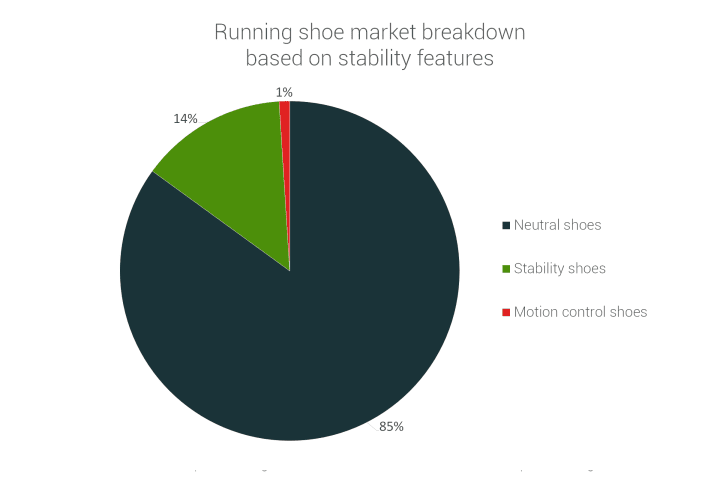
Arch support is not a quick fix. But, can running shoes with arch support improve your running experience? This is an in-depth guide that gives a necessary overview of arch height and running shoes with arch support.
Shoe fanatics should keep in mind that it’s the feet’s job to dissipate shock and actively stabilise during push-off. Not the shoes'.

If you’re experiencing pain, see a specialist. The purpose of this guide is to educate, not to make any medical diagnosis or recommendation.
Up: tall and narrow midsoles vs down: tall and wide midsoles
The human foot has three arches: medial longitudinal, lateral longitudinal and anterior transverse arch. In running, we usually focus on the medial longitudinal arch. Without them, we wouldn’t be able to stand, walk, run, jump.
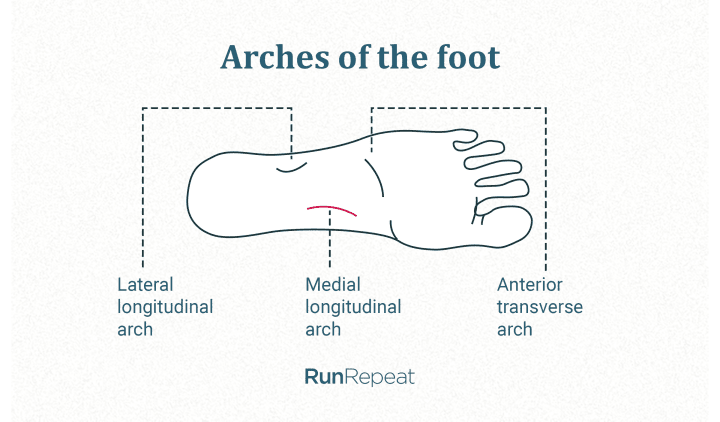
D means that they added 4 stability elements to the shoe. It includes:
- weight distribution,
- shock absorption (they help absorb impact while running), and
- propulsion (they provide energy to push us to the next step).
During the shock absorption and propulsion, the arch acts as a springboard. This springboard allows the middle of the foot to spread and close. That’s why it needs to be mobile (flexible).
Arch types based on their height
Based on the height of the arches, we differentiate 3 arch types:
- Low arches or flat feet
- “Normal” or medium arches
- High arches.
Whatever your arch type, your feet can be functional and healthy.

In flat feet, the entire bottom surface of the foot lays on the ground (in the weight-bearing position). It’s characterised by the failure of all 3 arches. However, low arches are different and the foot doesn’t have full-surface ground contact. It usually means that the arches are weak and too flexible, which leads to a lack of control over foot mobility.
High arches are usually characterised by rigid arches. This means they are not so good at shock absorption, dampening the gait forces and adapting to changes in terrain.
We’ve covered both arch types later on in separate sections (Flat feet and High arches). This study cut into pieces with the H-frame we sketched the left half in blue.
Flexible flat feet?
We measure arch height in order to characterise the foot arch type. This is usually done in a sitting and standing position and the two heights are compared. There are numerous methods for arch height determination: medial longitudinal arch angle, navicular drop test, arch height index,... all of which require you to visit a specialist.
Here, we will explain the visual test you can do yourself: the footprint analysis.
DIY: The wet test (footprint analysis)
Runners love this analysis, which makes it the most popular one.
- Pros: quick, easy, DIY, no fancy equipment needed.
- Cons: it doesn’t tell you the exact height of your arch, no standardised data to compare to, rather subjective.
Here’s how to do it:

Got your footprint? Compare it to the results:

It’s obvious that the line between the flat arch and the normal arch, as well as the line between the normal and the high arch, is rather blurry unless your foot belongs to the extreme (or perfect middle). Other than that, this test is a good indicator of your arch type.
Arch support and running shoes
“The more the merrier” can’t be applied to arch support. Sometimes it can get things worse by sending unreasonable stress to different joints and ligaments (as covered in this study and this book).
Based on the arch type, you can look for the shoes that might suit you.
| Arch height | Shoes to look for |
| Low or flat feet | Flat feet running shoes (stability shoes) |
| Normal or medium | Medium arch running shoes (stability or neutral shoes) |
| High | High arch running shoes (neutral shoes) |
Arch height is usually tightly connected to pronation. In this overview, you can see how it relates not only to pronation but also to the shoe wear and the type of shoes you should look for.

This stepping away from the “normal” or medium condition means our ankles compensate and that’s why overpronation tends to happen in feet with low arches and supination tends to happen in feet with high arches.
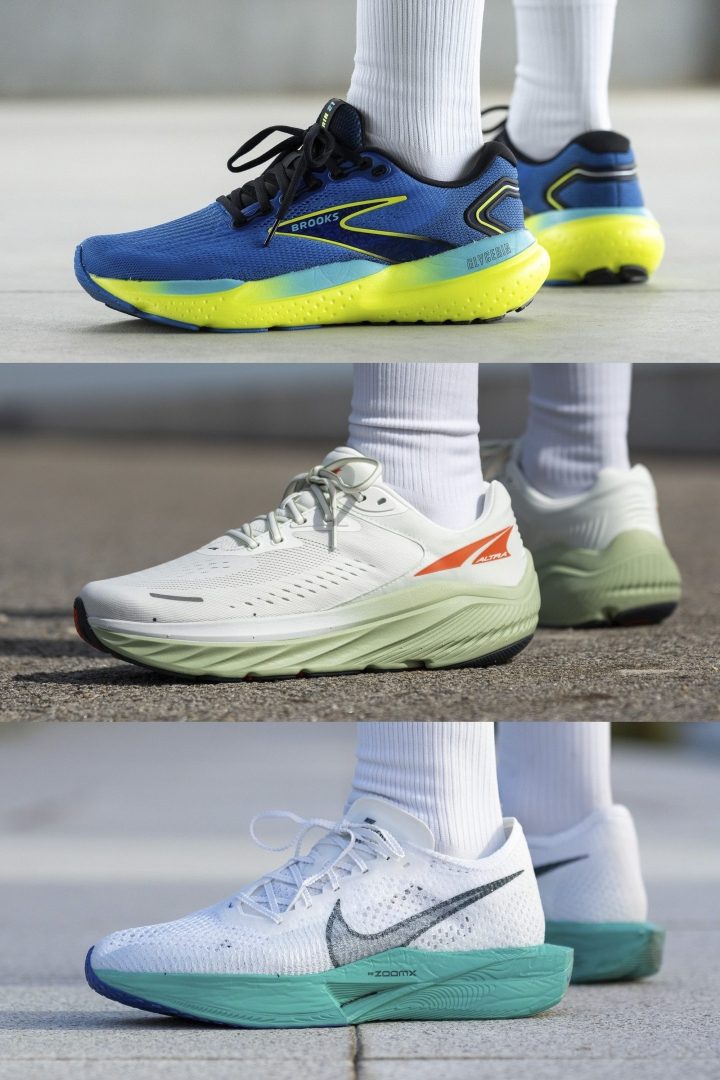
If you’re curious how all these shoes “feel” in your hands, this overview will help. It’s obvious that going from neutral running shoes over stability running shoes to motion control running shoes, the degree of arch support grows. It’s not only arch support, though, but also other features that help reduce the excessive pronation and stabilise your foot.
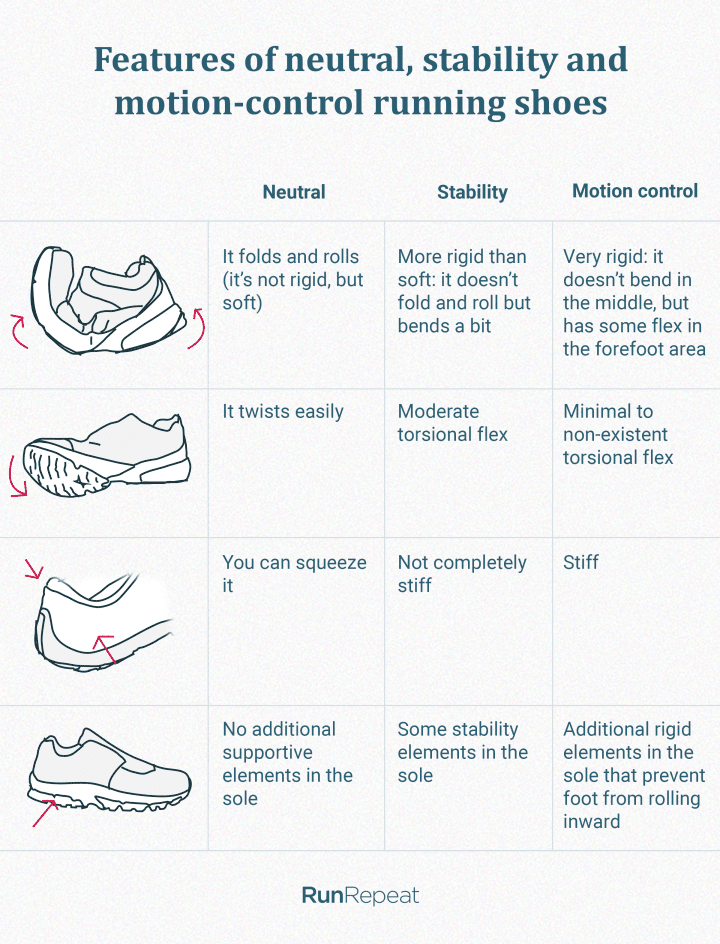

Pronation should not be defined by arch height only, as described in our in-depth guide on pronation. However, this is the most frequently used template and it tends to work for the majority of runners who have no serious issues. That’s why you should always consult a podiatrist if you’re experiencing any discomfort.
3-Arch support for high arches
If you have low arches or flat feet, you’ll probably need arch support in running shoes.
1) Determine your arch type
Do you have rigid flat feet, flexible flat feet, or low arches? D means that they added 4 stability elements to the shoe. It includes.
“Flat feet'' as a term has many meanings but doesn’t have a universal clinical definition. We’ve decided to follow Staheli because he additional flatfoot into only 2 groups: physiological and pathological flatfoot.
- Physiological flat feet: also called collapsed arches or flexible flat feet, Arch types based on their height.
- Pathological flat feet: also called rigid flat feet, they have anatomically flat arches.
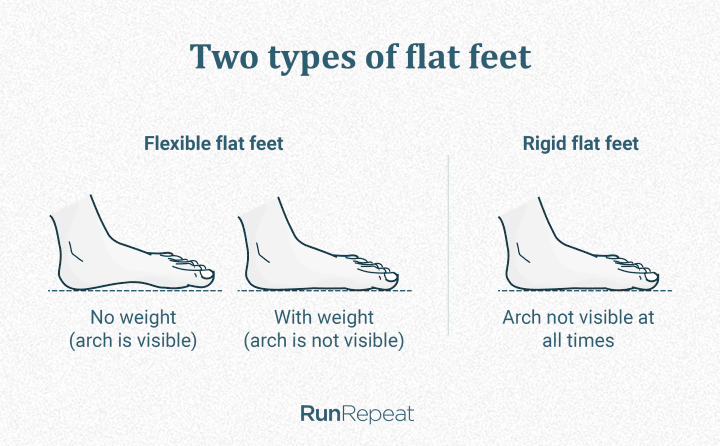
Still not sure which one you have? You can do two tests.
- Tiptoe test: rise up and stand on your tiptoes. If your arches form again, you have flexible flat feet.
- Jack’s test: have someone passively dorsiflex your great toe. If you have flexible flat feet, your arch will become noticeable.

This is how these two types of flat feet differentiate:
| Flexible flat feet | they happen due to muscle weakness |
| The arch is visible when there is no weight (ex. while sitting, on toes, or lying down); it disappears when weight is put on the legs. | Track and XC. |
| Usually painless | Normal or medium arches |
| See all articles | Usually affect one or both feet |
This means that, based on your arch type, you should look for
- Heres how to do it: if you have flexible flat feet and low arches (mild overpronation), or
- Motion-control shoes: if you have rigid flat feet (severe overpronation).
Both offer the support needed for overpronation; it’s the level of support that differentiates them. The line between these two types of shoes is often blurry. That’s why comfort should always be your #1 guidance.
Now that you know your arch type, you should look for features of the shoes that will make your run more comfortable and safe.
2) Best walking shoes
Running shoes for flat feet and low arches (so called stability shoes) often feature 2 or more of the following:
Medial post. This is a piece of plastic or firm foam located on the medial (inner) side, usually under the arch. It prevents (to a certain degree) the collapsing of the arch and the inward roll of the ankle.
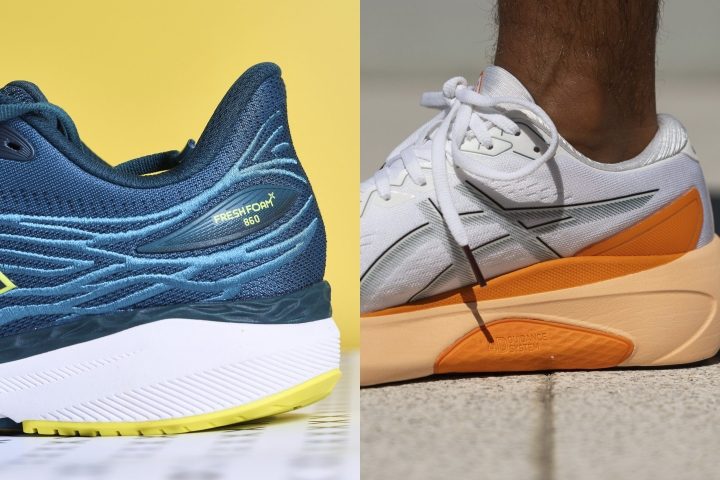
Dual-density midsole: appears as a firmer foam on the inside or under the arch or in other shapes that make the shoe more stable. In case of Hoka's trademarked technologies, it can be shaped like letter J or letter H as well.

When it comes to how soft these different foams are, we also dig deep into that: we measure both softness with a durometer. We cut the shoe in half and stick the shore A durometer needle into the foam. The lower the number, the softer the shoe.

When the shoe features a dual-density midsole, we take both measurements.

In case you prefer softer midsoles, here are the softest shoes for those who need stability:
And if you enjoy a firmer ride, here are the firmest shoes for those with flat feet or low arches:
Stiff and padded heel counters. The stiffness of the heel counter allows for a heel to stay put and not to wobble. The more stability, the merrier! And padding usually helps with the lockdown. Usually only race shoes have no padding and insanely soft heel area.


Before we cut shoes in half, we test the stiffness of the heel counter. We push it and squeeze it and assign it a rating of 1-5, where 1 is the least stiff.
Heel counter that scored 5/5 (the stiffest) rating on our test
A stiffer base is more stable, and in stability shoes, this is often accomplished by inserting plates or rods in the midsole.
In our lab, we test
- longitudinal stiffness by bending the shoe to 90 degrees using a digital force gauge
- torsional stiffness by twisting the shoe in our hands.
Measuring longitudinal stiffness in Stefoy-les-lyonShops lab
doing strength exercises for feet will not always help.
Assessing torsional rigidity in Stefoy-les-lyonShops lab
We assess the torsional rigidity on a 1-5 scale, where 5 is the stiffest.
Wide base ensures planted landings. By avoiding narrow and high platforms, as you’d see in some race shoes, we're making the ride more secure.
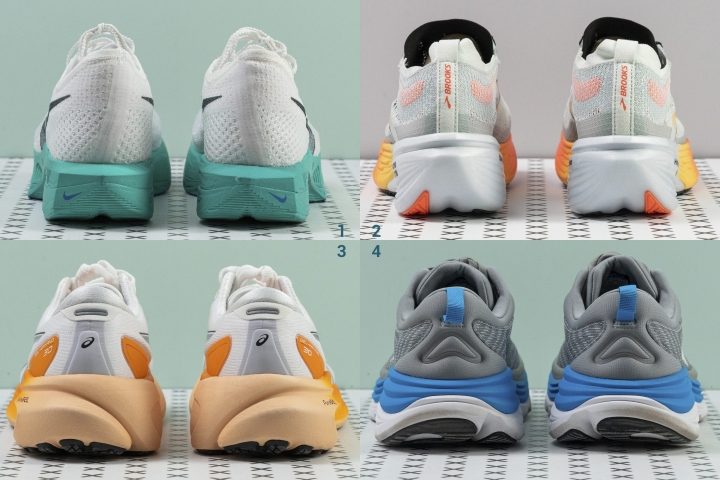
When it comes to how wide the base is, in our shoe lab, we measure it in 2 places: at the forefoot and at the heel. Of course, for heel strikers, the width of the base at the heel is more important as they want that extra stable landing.

Full-ground contact outsole means that a very big percentage of the outsole touches the ground. This is great for extra stability. But, some shoes have cutouts in the outsole to lose weight or to improve flexibility. That is not a bad thing, but when it comes to stability, more ground contact is better.

Side walls are midsole extensions that look like walls because they extend upwards. They provide more structure and prevent the foot from wobbling.
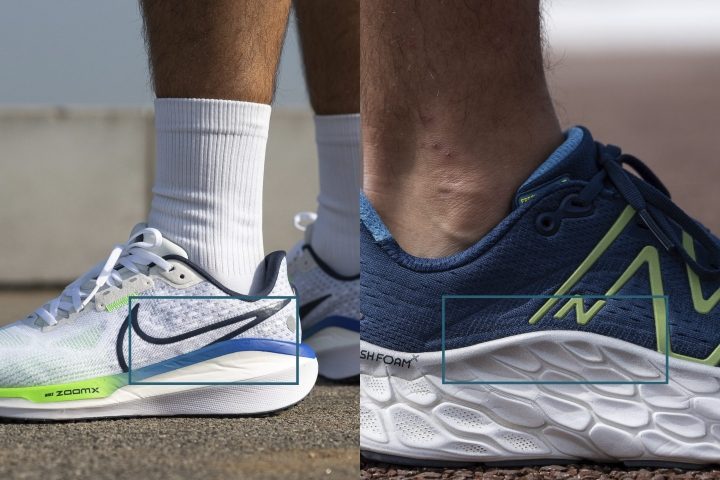
Heel bevel is basically a curved back of the heel. It's important because it imitates the shape of our heel bone which is curved. This helps with landing and transitions, especially for heel strikers.
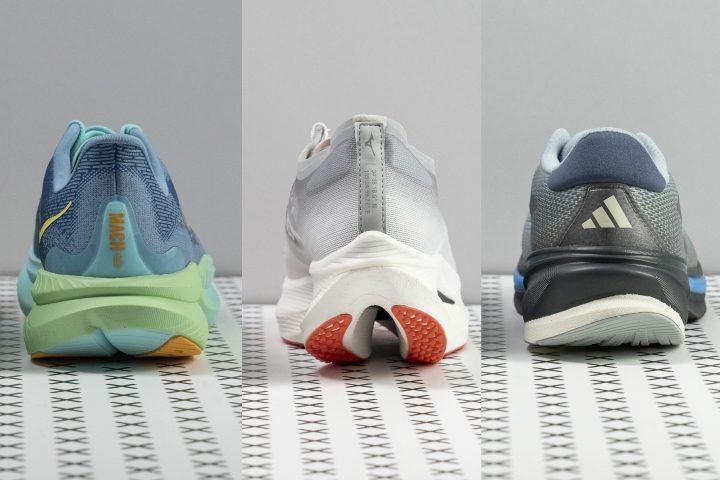
Sole flare is a sole protrusion that can appear both on the medial and lateral sides of the shoe. For heel strikers, it’s important that it’s present at the heel. This means that the protrusion midsole becomes wider than the upper as seen in the image below.
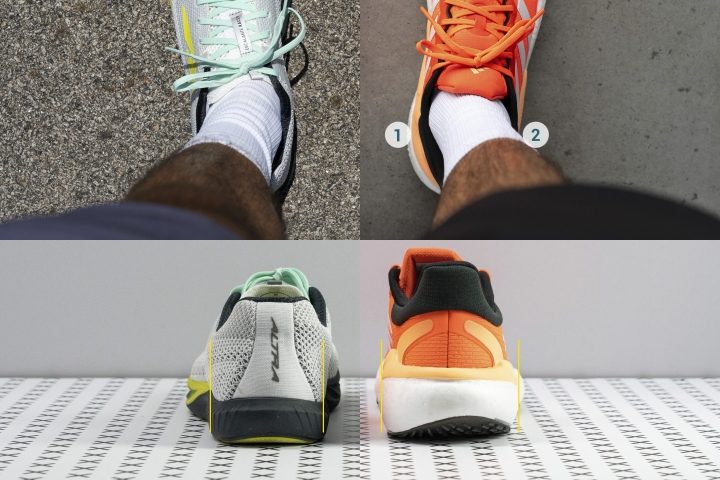
Those who pronate at the heel should look for a medial heel flare. Those who pronate at the forefoot can look for medial forefoot flare.
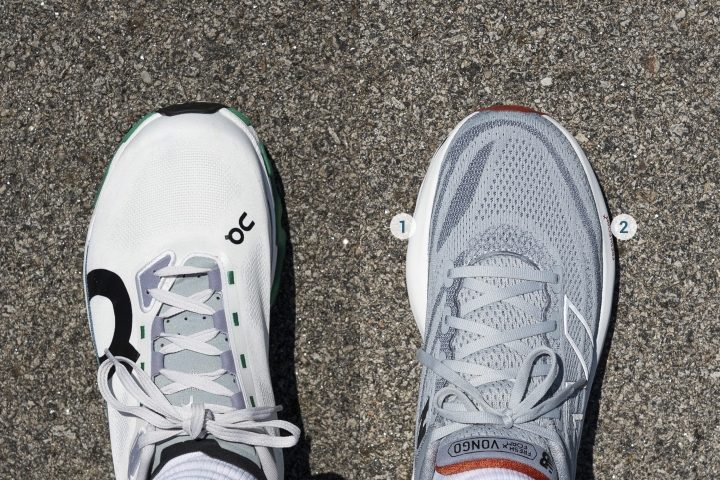
Flexible flat feet are overlays that are made of stiffer materials like synthetics or plastic and, with this stiffness, they give extra support and superb lockdown.
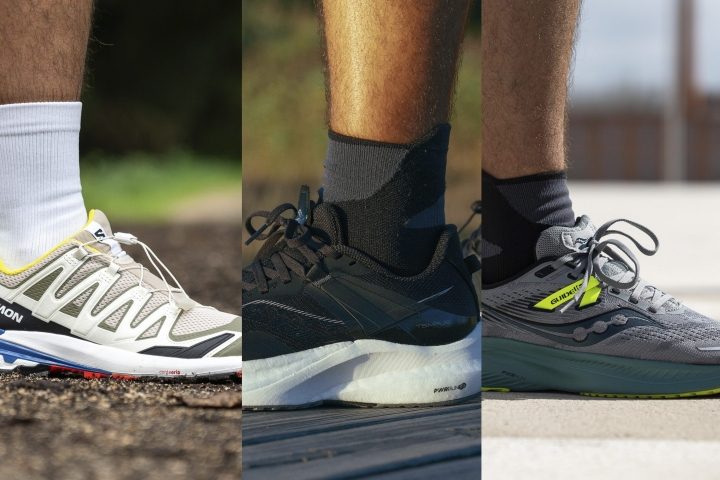
Using a digital calliper to measure the width of the base at the forefoot left and heel right
Different brands develop different technologies. We'll give a short overview of more popular ones here. Many are easily recognisable in case you don't want to remember their names.
GuideRails by Brooks
GuideRails are made of 2 pieces of firmer foam on either side of the heel. The inside piece reduces the rolling of the foot inward, while the outside piece is firmer and higher, and it stabilises the heel by reducing its outward motion.
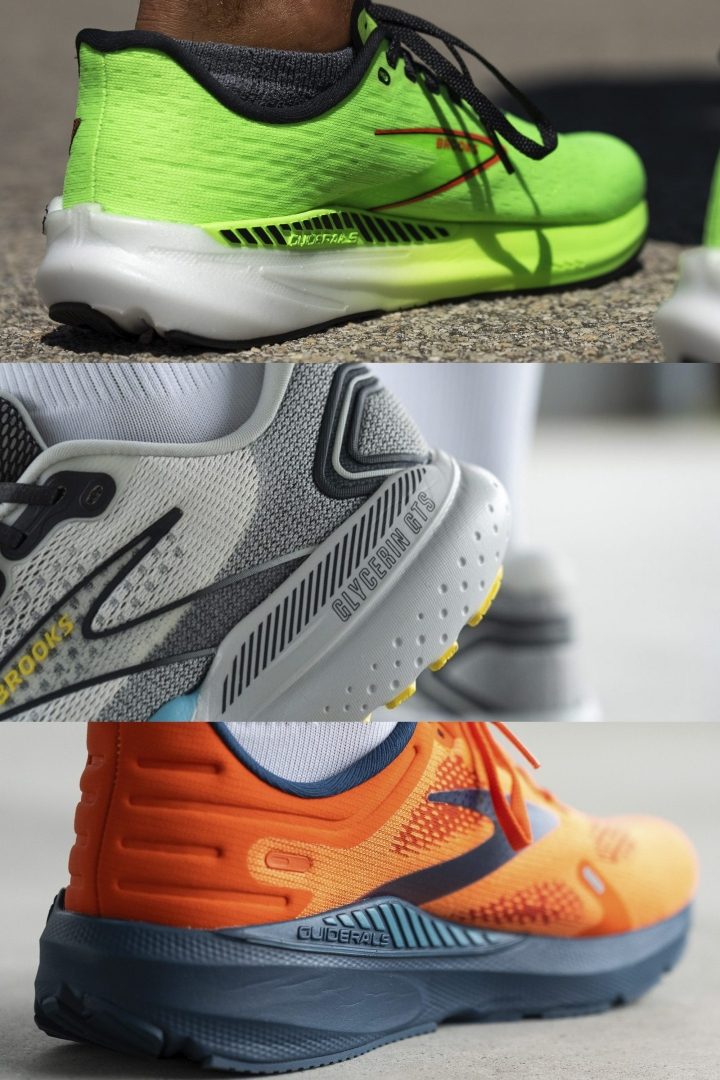
they happen due to muscle weakness
All the shoes from Brooks that utilise this technology are stability shoes, they have “GTS” (for go-to stability) in their name, and they are easy to recognise as the newer models have the GuideRails design in stripes.
GuideRail by Altra
Similar to the GuideRails from Brooks. There's a higher and firmer foam that offers medial support (on the inner side of the shoe).

Provision 7 and Paradigm 7 whether you have flat feet or high arches. These two studies
J-Frame by Hoka
J-frame is a supportive structure made of denser foam that gives extended heel support. This shape literally hooks around the heel forming the J shape. This shape is often of different colour so it's easy to notice. In the image below, firmer foam is grey, softer is white.
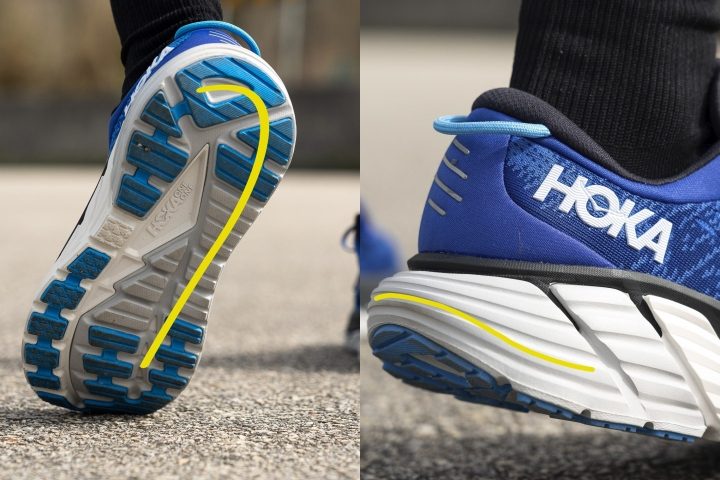
H-Frame by Hoka
H-Frame is a support structure made of denser foam that is more shaped like a number 8 than a letter H. The cutouts allow the foot to be in direct contact with the plush foam, which results in a stable, soft shoe.
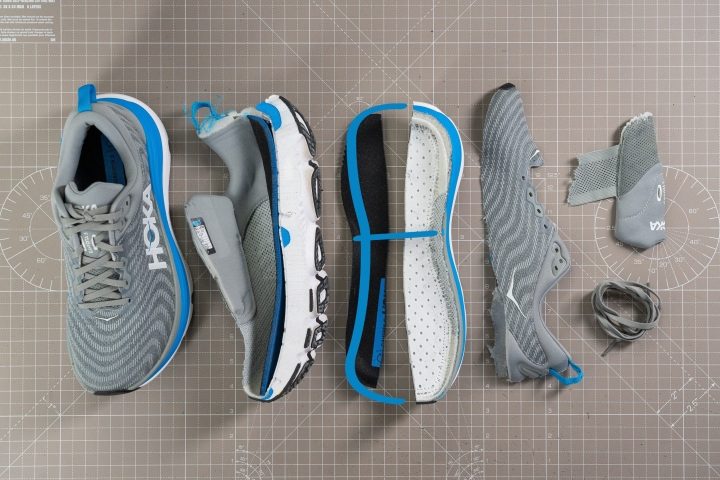
Hoka Gaviota 5 cut into pieces with the H-frame (we sketched the left half in blue)
4D guidance system by Asics
4D means that they added 4 stability elements to the shoe. It includes
- Low or flat feet
- sculpted midsole
- wider base
- medial post.

And if you enjoy a firmer ride, here are the firmest shoes for those with flat feet or low arches Asics Gel Kayano 30
3D guidance system by Asics
3Running shoes with arch support cost more
- Low or flat feet
- wider base
- forefoot flare.
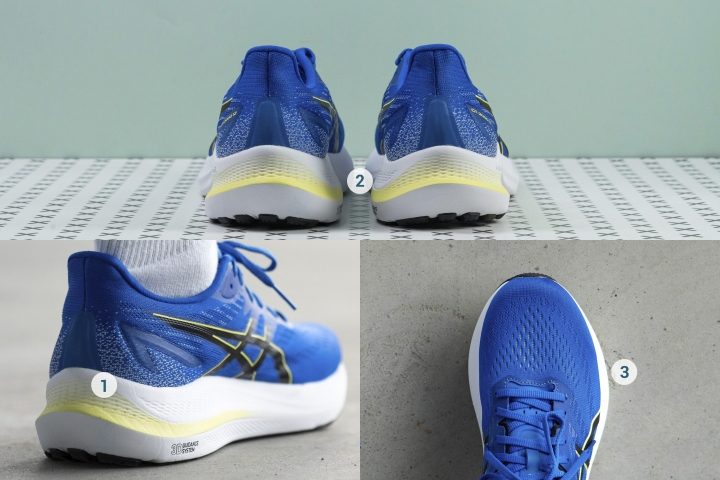
Close-up of all 3 elements of the 3D guidance system seen in Asics GT 2000 12
Mizuno’s Wave plate
This plate helps prevent the arch from collapsing and offers stability. It’s easy to notice on the shoe because it’s a different colour from the midsole.
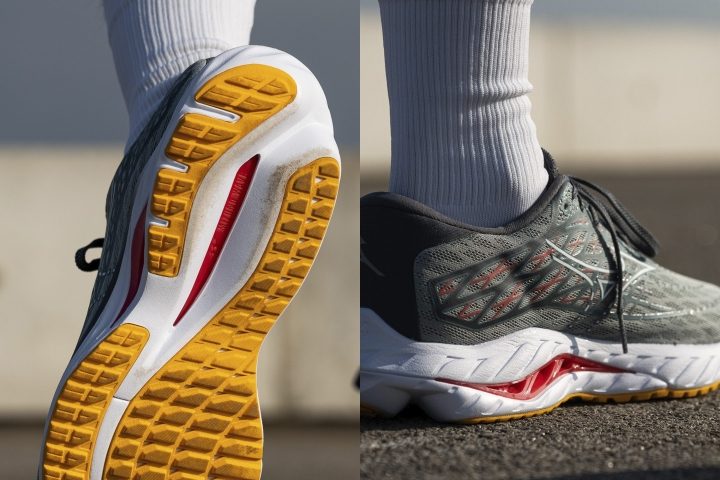
Mizuno Wave Plate (red) exposed on the outsole and visible on the lateral and medial side of the midsole
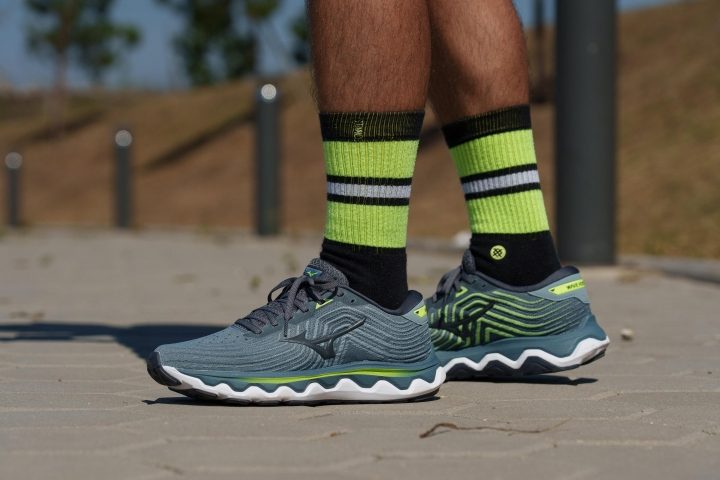
Mizuno’s Double fan-shaped wave
Similar to the Mizuno Wave plate but with a one-wave structure on the lateral side that cushions the foot AND a double fan-shaped wave on the medial side that prevents the arch from collapsing. It is present in Mizuno Equate shoes.
3) Try the shoe on and make sure it’s comfortable
Just because a specific shoe sounds great “on paper”, doesn’t mean it will work for you. Try it on and keep it only if it doesn’t take away from your running experience and overall comfort.
After a while, your feet muscles will get stronger. When buying another pair of shoes with arch support, it’s recommended to try shoes with less support and see if they work as well.
BONUS tip: not all stability and motion control running shoes work in the same way (feature list above, remember?). That’s why it’s imperative to give more than one shoe model a chance.
Arch support for high arches
People with high arches usually supinate (underpronate) and shoe brands don’t make specific shoes for them - they’re in the same bucket with people with normal (medium) arches. That’s why it’s important to know what to look for in a neutral running shoe.
Features of running shoes for high arches
When shopping for neutral running shoes for high arches it’s recommended that you look for these features:
- Neutral running shoes must be comfortable, no exceptions.
- Cushioned throughout, especially at the forefoot. Usually, high-arched runners land on their forefoot, so additional cushioning is welcomed. It will help with shock absorption.
- Under arch support, if it feels good.

Because runners with high arches tend to land on the forefoot, it's important they find shoes that have enough cushioning in that area. If you're already on this quest, you can look for exact stack height measurements in our reviews.
Per WorldAthletics guidelines, we measure heel stack height at 12% of the internal shoe length and forefoot stack height at 75%.
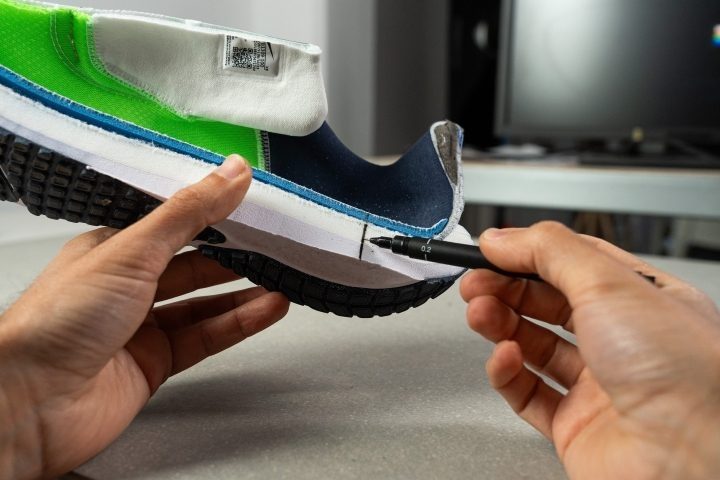

Here's our list of neutral running shoes with the highest forefoot stack height (these lists are dynamic, they update as we publish new shoe reviews):
And, in case you still want as much foam as possible at the heel, here's the "other way around" list:
Based on these numbers, we calculate the heel to toe drop. Forefoot strikers might enjoy a lower drop than those who land on their heels but it depends on the running form a lot, as well as on current and previous injuries.
| To learn which heel drop might be best for you, while taking account your running form, pronation and injuries, read our Low arches dont equal flat feet. |
Mythbusting: arch support nonsense ends here
We’re going to list facts that might be contradictory to what you’ve read/known before, but are worth knowing.
- How your feet work (function) matters more than their arch height. For example, this study has shown that impact forces during running don’t differ for different arch heights.
- We assess the torsional rigidity on a 1-5 scale, where 5 is the stiffest. Arch height wasn’t found to be a significant etiologic factor for overuse injuries in running (you can read more about this here).
- Low arches don’t equal flat feet.
- Not all flat feet are the same.
- Running shoes will not “fix” your arches nor pronation permanently. But, if your feet need special attention, a podiatrist will know that and might recommend insoles, orthotics, even surgery.
- Not all runners with high arches underpronate, just like not all runners with flat feet overpronate. Pronation is more than arch height.
- Arch support is not reserved for flat feet only. Runners with all types of arches might appreciate (and benefit from) arch support.
- Running shoes should be recommended based on the individual running mechanic. When that’s not possible, look at arch types (as explained here). This study has shown that selecting running shoes based on arch height had little influence on injury risk (in military training).
- When it comes to treatment, contrary to the popular belief, doing strength exercises for feet will not always help - whether you have flat feet or high arches. These two studies
have explained this in-depth. For this, an individual approach is imperative.
The higher the number on our force gauge, the stiffer the shoe
Using Stefoy-les-lyonShops data, we can see that the more support you look for in a shoe, the more money you should set aside.
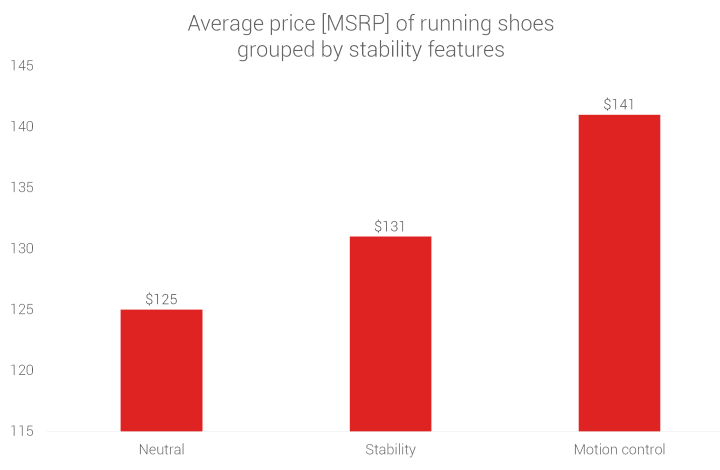
We can also see that only 15% of running shoes on the market were made for people with low arches or flat feet.
